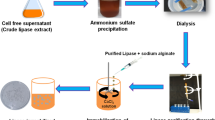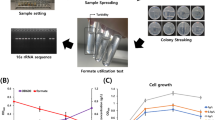Summary
WhenMortierella elongata NRRL 5513 was cultured in shake flasks at 25°C, mycelial growth reached a stationary phase at 48 h but maximum eicosapentaenoic acid (EPA) production was observed at 6 days. When incubated at 11°C, EPA production also continued to rise during the stationary phase of growth, reaching a maximum after 10 days. An initial culture pH of 6.1 was found to be optimum for EPA production. The effect of temperature on EPA production was dependent on medium constituents. In glucose and linseed oil supplemented media, optimum temperature for EPA production was 11 and 15°C respectively. A maximum EPA yield of 0.61 g/l was obtained in linseed oil (2%), yeast extract (0.5%) supplemented basal medium. Maximum EPA content as a percentage of lipids (15.12%) was observed when the latter medium was supplemented with 0.25% urea.
Similar content being viewed by others
References
Bajpai, P., P.K. Bajpai and O.P. Ward. 1990. Eicosapentaneoic acid (EPA) production by fungi. Abstr. Soc. Indust. Microbiol. Conf. on Novel Microbial Metabolites, Sarasota, October 1990, p. 27.
Bajpai, P.K., P. Bajpai and O.P. Ward. 1991. Arachidonic acid production by fungi. Appl. Environ. Microbiol. 57: 1255–1258.
Bligh, E.G. and W.J. Dyer. 1959. A rapid method of total lipid extraction and purification. Can. J. Biochem. Physiol. 37: 911–917.
Braden, L.M. and K.K. Caroll. 1986. Dietary polyunsaturated fat in relation to mammary carcinogenesis in rats. Lipids 21: 285–288.
Brock, T.D. 1967. Life at high temperatures. Science 158: 1012–1019.
Dyerberg, J. 1968. Linoleate-derived polyunsaturated fatty acids and prevention of atherosclerosis. Nutr. Rev. 44: 125–134.
Erwin, J. 1973. Comparative biochemistry of fatty acids in eucaryotic microorganisms. In: Lipids and Biomembranes of Eucaryotic Microorganisms (Erwin, J.A., ed.), pp. 41–143. Academic Press, New York.
Gregory, M. and M. Woodbine. 1953. Microbiological synthesis of fat. J. Exp. Bot. 4: 314–318.
Hansson, L. and M. Dostalek. 1988. Effect of culture conditions on mycelial growth and production of γ-linolenic acid by the fungusMortierella ramanniana. Appl. Microbiol. Biotech. 28: 240–246.
Holub, B.J. and C.M. Skeaff. 1987. Nutritional regulation of cellular phosphatidylinositol. Methods Enzymol. 141: 234–244.
Kates, M. and P.-O. Hagen. 1964. Influence of temperature on fatty acid composition of psychrophilic and mesophilicSerratia species. Can. J. Biochem. 42: 481–488.
Lands, W.E.M.. 1986. The fate of polyunsaturated fatty acids. In: Health Effects of Polyunsaturated Fatty acid in Seafoods (Simopoulos, A.P., R.R. Kifer and R.E. Martin, eds.), pp. 319–351, Academic Press Inc., Orlando.
Marr, A.G. and J.L. Ingraham. 1962. Effect of temperature on the composition of fatty acids inEscherichia coli. J. Bacteriol. 84: 1260–1267.
Mortensen, J.Z., E.B. Schmidt, A.H. Nielson and J. Dyerberg. 1983. The effect of n-6 and n-3 polyunsaturated fatty acids in homostasis, blood lipid and blood pressure. Thromb. Haemostas. (Stuggart). 50: 543–546.
Reddy, B.S. and H. Maruyama. 1986. Effect of dietary fish oil on aroxymethane induces colon carcinogenesis in male F344 rats. Can. Res. 46: 3367–3370.
Robinson, D.R., J.D. Prickett, G.T. Makoul, A.D. Steinberg and R.B. Colvin. (1986). Dietary fish oil reduces progression of established renal disease in (NZBX NZW)F1 mice and delay renal disease in BXSB and MRL/1 strains. Arth. Rheum. 29: 539–546.
Seto, A., H.L. Wang and C.W. Hesseltine. 1984. Culture conditions affect on eicosapentaenoic acid content ofChlorella minutissima. J. Am. Oil Chem. Soc. 61: 892–894.
Shaw, R. 1966. The polyunsaturated fatty acids of microorganisms. Adv. Lipid Res. 4: 7–174.
Shimizu, S., Y. Shinmen, H. Kawashima, K. Akimoto and H. Yamada. 1988. Fungal mycelia as a novel source of eicosapentaenoic acid. Biochim. Biophys. Acta 150: 335–341.
Shimizu, S., H. Kawashima, K. Akimoto, Y. Shinmen and H. Yamada. 1989. Microbial conversion of oil containing α-linolenic acid to an oil containing eicosapentaenoic acid. J. Am. Oil Chem. Soc. 66: 342–347.
Singh, J. and T.K. Walker. 1956. Changes in the composition of the fat ofAspergillus nidulans with age of culture. Biochem. J. 62: 286–289.
Sumner, J.L., E.D. Morgan and H.C. Evans. 1969. The effect of growth temperature on the fatty acid composition of fungi in the order Mucorales. Can J. Microbiol. 15: 515–520.
Urakaze, M., T. Hamazaki, Y. Soda, M. Miyamoto, F. Ibuki, S. Yano and A. Kumagai, 1986. Infusion of emulsified trieicosapentaenoyl-glycerol into rabbits. The effects on platelet aggregation, polymorphonuclear, leukocyte adhesion and fatty acid composition in plasma and platelet phospholipids. Thromb. Res. 44: 673–682.
Van der Wende, L.A. 1988. Omega-3 fatty acids: algal and fish fatty acids could net $790 million, but markets need backing of medical industry. In: Biomarkets: 33 Market Forecasts for Key Product Areas, pp. 199–203, Technical Insight Inc., New Jersey.
Walker, P. and M. Woodbine. 1975. The biosynthesis of fatty acids. In: The Filamentous Fungi, Vol. 2: Biosynthesis and Metabolism. (Smith, J.E. and D.R. Berry, eds.), pp. 136–158. Edward Arnold. London.
Wassef, M.K. 1977. Fungal lipids. In: Advances in Lipid Research (Paoletti, A. and D. Kritchevsky, eds.), 15, 159–232. Academic Press, New York.
Yongmanitchai, W. and O.P. Ward. 1989. Omega-3 fatty acids; Alternative sources of production. Proc Biochem. 24: 117–125.
Yongmanitchai, W. and O.P. Ward. 1991. Growth of and Omega-3 fatty acid production byPhaeodactylum tricornutum under different culture conditions. Appl. Environ. Microbiol. 57: 419–425.
Ziboh, V.A., K.A. Cohen, C.N. Ellis, C. Miller, T.A. Hamilton, K. Kragballe, C.R. Hydrick and V.J. Voorhees. 1986. Effect of dietary supplementation of, fish oil on neutrophil and epidermal fatty acids: Modulation of clinical course of psoriatic subjects. Arch Dermatol 122: 1277–1282.
Author information
Authors and Affiliations
Rights and permissions
About this article
Cite this article
Bajpai, P.K., Bajpai, P. & Ward, O.P. Optimisation of culture conditions for production of eicosapentaenoic acid byMortierella elongate NRRL 5513. Journal of Industrial Microbiology 9, 11–17 (1992). https://doi.org/10.1007/BF01576363
Received:
Accepted:
Issue Date:
DOI: https://doi.org/10.1007/BF01576363




